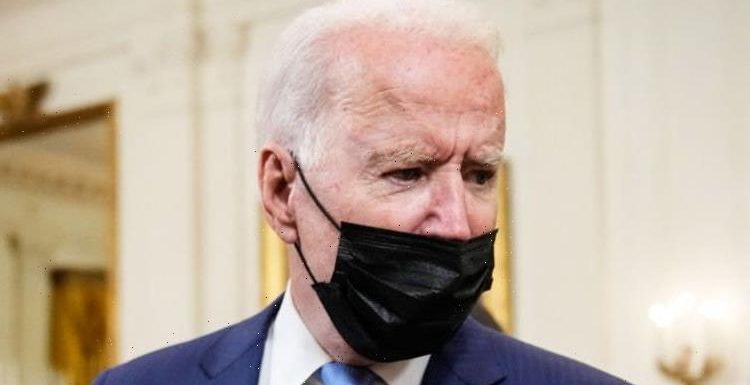
Delta variant: Expert on vaccines’ impact on transmissibility
We use your sign-up to provide content in ways you’ve consented to and to improve our understanding of you. This may include adverts from us and 3rd parties based on our understanding. You can unsubscribe at any time. More info
The research, published today in Nature, indicates by the end of 2020, roughly a third of the US population had been infected with the disease – which proved far more deadly than either seasonal influenza or the 2009 influenza pandemic. The percentage of confirmed and predicted infections rose between March and December – but the infection fatality rate falls during the course of the year.
The introduction to the report explains: “This research adds to our understanding of how SARS-CoV-2 spreads, which may offer insights on how to control it in the future.
“The USA experienced the highest numbers of confirmed COVID-19 cases and deaths in the world during 2020, with more than 19.6 million reported cases by the end of the year.”
In order to quantify the characteristics of the COVID-19 pandemic in the US, lead author Jeffrey Shaman and his colleagues at Columbia University in New York devised a model simulating the transmission of SARS-CoV-2 within and between all 3,142 US counties.


They calibrated their models with migration data between counties and observed case numbers and estimates of infections based on seroprevalence estimates – in other words, the number of persons in a population who test positive for SARS-CoV-2 antibodies.
The analysis enabled the estimation of the percentage of infections confirmed diagnostically at county and national levels.
The report explains: “At a national level, this value increased from 11.3 percent in March 2020 to 24.5 percent in December 2020, which may be partially attributed to increasing test availability and increasing awareness of the public.
JUST IN: China set to cash in on Afghanistan’s mining reserves

“Local variations were observed in five major metropolitan areas studied by the authors; ascertainment rates for Miami and Phoenix were higher than the national average, whereas these rates were lower than the national average in New York City, Los Angeles and Chicago.”
The percentage of people with a contagious infection reached 0.77 percent on December 31, 2020, suggesting roughly one in 130 people was contagious, and as high as 2.42 percent in Los Angeles during December, meaning almost one in 40 people was contagious.
The report adds: “At the end of 2020, the proportion of the US population that had not been infected was 69 percent, although this varied regionally, with areas of the upper Midwest and Mississippi valley estimated to have population susceptibility below 40 percent by December 31 2020.
DON’T MISS
Penny Lancaster is ridding the stigma of her disability – symptoms [INSIGHT]
Covid warning: Israel expands booster jabs as 4th wave explodes [ANALYSIS]
More than 1,000 test positive after attending Latitude Festival [UPDATE]


“The infection fatality rate fell from 0.77 percent during April to 0.31 percent in December, which the authors attribute to earlier diagnosis and treatment, improved patient care and reduced disease severity.
“However, they note that the infection fatality rate is still greater than estimates for both seasonal influenza (0.08 percent) and the 2009 influenza pandemic (0.0076 percent).
“They suggest that, as COVID-19 deaths are probably under-reported, their estimate of infection fatality rate may be low.’

A separate report also published by Columbia University yesterday highlighted the rise of a mutant strain of COVID-19 in New York City, which appeared to be at least partially resistant to vaccinations.
Lead author David Ho and his team said the strain, B.1.526, also known as the Iota variant, showed worrying similarities with other variants of concern.
Speaking to Columbia’s website in February, Mr Ho warned: “The rise of these variants shows that we may be chasing after SARS-CoV-2 for some time.

“Unfortunately, this pandemic may not go away so easily with the advent of the vaccines.”
Mr Biden was elected US President in November 2020, and made rolling out the Coronavirus vaccine his number one priority.
As of yesterday, 51.24 percent of Americans had been given two vaccine doses, with another 9.27 percent having one.
The Delta variant, which is significantly more infectious and more vaccine-resistant than the original strain of COVID-19, is currently fuelling the spread of the diseases in the US.
Source: Read Full Article